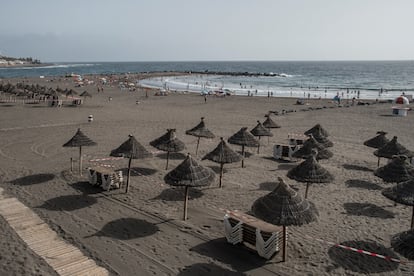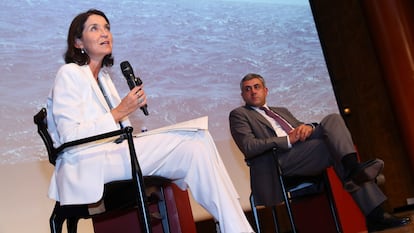Spain’s Canary Islands feeling the absence of foreign tourists
Businesses are having a tough time getting the summer season back on track due to fears of flying amid the Covid-19 crisis


The sight of 15 people walking along Calle Mequinez, one of the most beautiful streets in Puerto de la Cruz in Tenerife, raises eyebrows among the locals. “I think it’s the first group of tourists I have seen,” says one in a strong local accent, apparently surprised at seeing tourists in a tourist area.
Nearby, on Muelle beach, the bathers are tellingly olive-skinned. There is no blond hair or burned shoulders coated in sun cream struggling to do its job. A few yards on, a group of children are jumping off the pier into the water, clearly familiar with the spot, knowing exactly where to climb back up to jump in again.
It’s midday in July and foreign tourists are a rare species these days in the once popular resort of Santa Cruz de Tenerife. The intrepid few who have made the journey from Germany and Belgium look uncomfortably aware that they are conspicuous in what should be their natural habitat.
We need planes filled with tourists if we are to recoverYaiza Castilla, regional chief of tourism
Spain’s Canary Islands are now facing their biggest tourist challenge in decades despite a relatively low incidence of Covid-19 cases – a recorded 2,460 with 162 fatalities for a population of 2.2 million, according to the latest data from the regional authorities. Both domestic and international tourists who numbered over 13 million in 2019 are in scarce supply these days, with the islands of Lanzarote and Tenerife particularly badly hit.
“We are having a pretty strange summer season,” says Jorge Marichal, president of the Ashotel industry association and of the Spanish Confederation of Hotels and Tourist Accommodation (CEHAT). “We are immersed in an economic crisis triggered by an illness, and we have to inject confidence back into the equation,” he says, using figures to illustrate the current slump in the sector. “At the moment, not even 20% of Tenerife’s hotels are open.”
Between the islands of Gran Canaria, Tenerife, Fuerteventura, Lanzarote, La Palma, El Hierro and La Gomera, there are 646 hotels and 1,132 alternative tourist establishments, amounting to 415,752 beds – 254,959 and 160,703, respectively. But due to the coronavirus crisis, Gran Canaria, Tenerife and Lanzarote have only around 10% availability this July, while Fuerteventura has put only a third of its supply on the market. In El Hierro, the wildest of the seven Canary islands, around 50%, of its rural houses are occupied, a figure which is expected to rise to 90% in August.
Flights

“We need planes filled with tourists if we are to recover,” says Yaiza Castilla, the regional chief of Tourism, Industry and Trade. “In the pre-Covid era, we had 1,458,044 seats on flights, and now there are barely 450,000. We are working on finding formulas that will stimulate demand, such as a per-seat subsidy for the airlines.”
Compared to the 3,689,102 tourists – both national and international – who visited the islands between July and September of last year, the summer of 2020 is set to plummet with a huge impact on the region’s coffers.
According to data from the regional tourism department, the sector generated over €15 billion last year, of which nearly €1.5 billion was from domestic tourism. The average expenditure per visitor per trip was €1,136 euros (€842 for domestic tourists) or €138.9 per day (€135.6 for domestic tourists). As yet, the authorities are not in a position to estimate the turnover for this year.
The visit last week by the Secretary General of the World Tourism Organization (UNWTO), Zurab Pololikashvili, showed that international authorities are also keen to boost confidence in air travel, which is so crucial to the tourism industry in the Canary Islands. “We have more cancellations than reservations at the moment because there are still people who are afraid of flying, but we hope that in winter things will improve substantially,” says Marichal, while Castilla hopes that in the second half of July more tourists will start to arrive from the United Kingdom.
Missing the Brits

In 2019, the main sources of tourism to the Canaries were the United Kingdom (18 million), Germany (11.1 million) and France (11 million). “You can tell that the English are missing,” says Roxana, who works at a hamburger restaurant on the promenade of Los Cristianos beach, in the south of Tenerife. “Although many islanders have their second home here, and they are here now, you can see the foreigners are not there.”
Her view is confirmed by Antonio, a waiter at Bahía coffee bar. “There are many tourists from Santa Cruz, but on weekdays you see very few people.” And Yaiza, who works at the Kiko&Hijas kiosks, adds, “I’m selling, but not much. And even that is just thanks to the fact that the supermarkets in this area are still closed. What scares me the most is that there will be more outbreaks and everything will come to a halt again.”
Meanwhile, in El Arrozal, only one bar is open on the ghostly Avenida de Las Américas. “There are usually nine of us, but just three of us are working now, because the others are on furlough,” explains a waiter named Joseph.
But according to regional tourism chief Castilla, there is light at the end of the tunnel. “We hope that over the winter, between October and December, which is our high season, the situation will improve and we will reach 60% occupancy,” she says, while Marichal is less upbeat. “Prospects for autumn and winter are better than what we are currently experiencing, but they are still very different from other years,” says the hotel industry leader. “We are talking about a drop in activity of more than 50%. Although I am confident that we will all get through this crisis, the reality is that anyone can fall.”
English version by Heather Galloway.









































